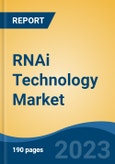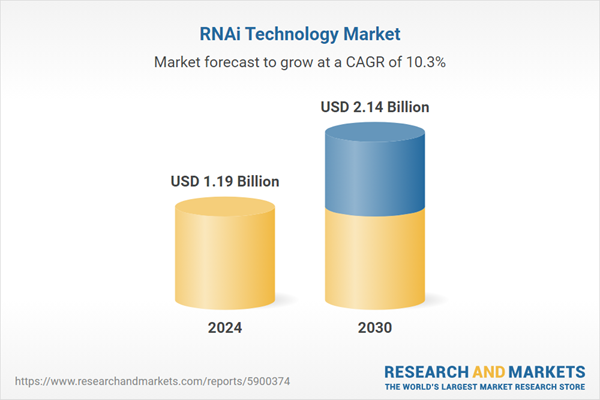Speak directly to the analyst to clarify any post sales queries you may have.
10% Free customizationThis report comes with 10% free customization, enabling you to add data that meets your specific business needs.
With its ability to selectively inhibit disease-related genes, RNAi is increasingly being integrated into drug pipelines for treating complex conditions such as cancer, genetic disorders, and viral infections. Pharmaceutical companies are prioritizing RNAi-based approaches due to their high precision, adaptability, and potential for developing personalized treatments. The continuous advancements in delivery systems, coupled with growing investments in RNAi therapeutics and diagnostics, are expected to drive robust market expansion through 2030.
Key Market Drivers
Growing Demand for RNAi-based Therapeutics
The rising demand for RNAi-based therapeutics plays a critical role in propelling the growth of the global RNAi technology market. RNAi enables highly targeted treatment by silencing genes that contribute to the progression of chronic and genetic diseases, such as certain cancers, viral infections, and neurodegenerative conditions. As the global prevalence of such disorders continues to rise, there is a growing need for precise and less invasive treatment options.RNAi-based drugs support a personalized medicine approach, tailoring therapies based on individual genetic profiles and minimizing off-target effects. The successful commercialization of RNAi therapies, such as Onpattro, has strengthened confidence in the clinical viability of these treatments, encouraging more companies to invest in research and development. Furthermore, RNAi’s utility in functional genomics and target validation makes it a valuable tool in drug discovery, reinforcing its expanding role across both therapeutic and research domains.
Key Market Challenges
Off-Target Effects
Off-target gene silencing presents a major obstacle to the widespread adoption of RNAi technology. Although RNAi is known for its precision, unintended interactions with non-target genes can lead to undesired cellular responses, including toxicity or immune reactions. These safety concerns require extensive preclinical and clinical validation, increasing development time and costs. Designing RNAi molecules with high specificity remains a complex task, particularly when targeting genes in complex biological systems. Off-target effects not only compromise therapeutic outcomes but also affect research accuracy in functional genomics. Addressing this challenge involves improving RNA sequence design, refining delivery mechanisms, and enhancing regulatory oversight to ensure the safe application of RNAi in both clinical and research settings.Key Market Trends
Precision Medicine and Personalized Therapies
The integration of RNAi technology into precision medicine is a significant trend shaping the future of the healthcare industry. As personalized therapies become increasingly important, RNAi's ability to silence specific genetic mutations makes it an ideal platform for individualized treatment strategies. In oncology, for instance, RNAi-based therapies are being developed to target genetic mutations unique to different tumor types, offering greater efficacy and reduced side effects compared to conventional therapies. This alignment with personalized medicine is also driving partnerships and R&D efforts focused on developing tailored RNAi-based solutions. By enabling gene-specific modulation, RNAi supports the broader shift toward customized, data-driven healthcare approaches.Key Players Profiled in this RNAi Technology Market Report
- Alnylam Pharmaceuticals, Inc
- Ionis Pharmaceuticals, Inc.
- Atalanta Therapeutics
- Phio Pharmaceuticals
- Benitec Biopharma
- Novartis AG
- AstraZeneca
- Silence Therapeutics
- Arbutus Biopharma
- Sylentis S.A.
Report Scope:
In this report, the Global RNAi Technology Market has been segmented into the following categories, in addition to the industry trends which have also been detailed below:RNAi Technology Market, by Type:
- Micro RNA
- Small interfering RNA
- Others
RNAi Technology Market, by Application:
- Treatment Type
- Therapeutics
- Drug Delivery
- Agriculture
- Others
RNAi Technology Market, by End User:
- Research and Academic Laboratories
- Diagnostic Laboratories
- Others
RNAi Technology Market, by Region:
- North America
- United States
- Canada
- Mexico
- Europe
- France
- United Kingdom
- Italy
- Germany
- Spain
- Asia-Pacific
- China
- India
- Japan
- Australia
- South Korea
- South America
- Brazil
- Argentina
- Colombia
- Middle East & Africa
- South Africa
- Saudi Arabia
- UAE
Competitive Landscape
Company Profiles: Detailed analysis of the major companies present in the Global RNAi Technology Market.Available Customizations:
With the given market data, the publisher offers customizations according to a company's specific needs. The following customization options are available for the report.Company Information
- Detailed analysis and profiling of additional market players (up to five).
This product will be delivered within 1-3 business days.
Table of Contents
Companies Mentioned
The leading companies profiled in this RNAi Technology market report include:- Alnylam Pharmaceuticals, Inc
- Ionis Pharmaceuticals, Inc.
- Atalanta Therapeutics
- Phio Pharmaceuticals
- Benitec Biopharma
- Novartis AG
- AstraZeneca
- Silence Therapeutics
- Arbutus Biopharma
- Sylentis S.A.
Table Information
| Report Attribute | Details |
|---|---|
| No. of Pages | 185 |
| Published | May 2025 |
| Forecast Period | 2024 - 2030 |
| Estimated Market Value ( USD | $ 1.19 Billion |
| Forecasted Market Value ( USD | $ 2.14 Billion |
| Compound Annual Growth Rate | 10.2% |
| Regions Covered | Global |
| No. of Companies Mentioned | 11 |









